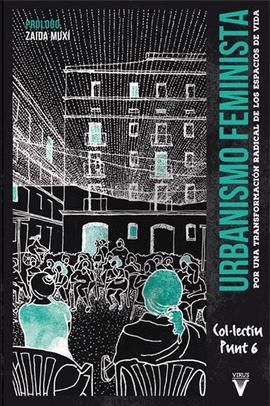Cities that care: transforming space to prioritise life
- Mar 22
- 8 mins

Prioritising the sustainability of life involves providing the material and immaterial conditions that support care. In the urban planning sphere, this means breaking away from the public/private dichotomy, as care does not take place in a specific space or at a specific time. The material conditions needed for care transcend spatial and temporal boundaries.
The concept of care has become popular in recent years, coinciding with the rise of feminism, though academic study in the area dates back to the eighties. The expansion of the term has made more and more people aware of the central role played by care. However, it has also led to a loss of critical perspective and has loaded the concept with certain connotations of naivete.
All of us are vulnerable and dependent on others, but on top of that, the percentage of the population that requires more intense, more continuous care is rising constantly. In Catalonia in 2021, the dependency ratio (the number of dependent people – aged under 16 or over 64 – compared with the total population aged between 16 and 64) was 50.7%, according to the Statistical Institute of Catalonia (Idescat). Furthermore, in 2020, there were 616,053 people with disabilities in Catalonia, 3 out of 4 adults declared that they had a chronic illness, and 140,000 were dependent in some way.
If we look at who is taking responsibility for caring for older and dependent people, we see that, in 85% of cases, it is women, when it comes to both paid care work and care given in the framework of family responsibilities and gender roles. The excess load placed on women in terms of care is clear to see: according to the last survey carried out, in 2011, women dedicate twice as many hours every day to looking after the home and the family as men do. From this point of view, it is evident that a lack of comprehensive, continuous policies that support care penalises women especially.
Beyond its feminisation, care in itself can generate inequality. This situation is consistent across the board, across all care-related positions, including workers in the care industry and carers of dependent people or people with functional diversity who look after themselves or others.
The spatial and temporal dimension
The precarious nature of care is closely linked to its spatial and temporal dimension. An increase in the visibility of care in the public sphere has not been accompanied by specific action to improve things in material terms. This opens up a split between growing care needs and the planning of the urban space.
This lack of response in the public sphere highlights the so-called ‘care crisis’ even more. According to María José Aguilar, this crisis is the result of the demographic transition (increased life expectancy, ageing population, higher prevalence of chronic illnesses and functional limitations) and of the gradual surmounting – not elimination – of certain forms of gender-based division of work (reconfiguration of structures, dynamics, scopes, values and conditions of coexistence, significant reduction of availability in the family, in the community and, in particular, among women for care, etc.).[1] These new social and family needs can only be fulfilled through an effective, equal distribution of care tasks within the home and sufficient public policies to make a real balance between family, work and personal life possible.
The lack of social appreciation for care translates as public policies that do not cover the needs deriving from sustainability of life when, for example, public spaces are designed, mobility networks and timetables are organised, and cultural, social, sport or leisure programmes are drawn up.
Modern cities have taken shape based on the public/private dichotomy, which is built on the gender-based division of work. The public space was for economic, political and cultural life, and was therefore linked to men, while private spaces were for reproduction and care, and so were assigned to women. This cultural construct was consolidated from the industrial revolution in Europe and the USA onwards, and it situated men and productive activities in the public space, and women and reproductive and care activities in the domestic space.
[1]Aguilar Idáñez, María José, ‘Cuidados y migraciones: Una crisis global que afecta seriamente la salud de las mujeres’. In: Pérez Alonso, Edith; Girón, Antonio, and Ruiz-Giménez, Juan Luis (coord.), Los cuidados: Saberes y experiencias para cuidar los barrios que habitamos. Libros en Acción, 2019, pp. 61–67.
It is clear that our urban spaces are not designed to provide physical support for vulnerability, which is an integral part of life.
It is clear that our urban spaces are not designed to provide physical support for vulnerability, which is an integral part of life. Just take a look at the space taken up by cars on the street in comparison to the area designated to people, the number of benches in proportion to the seats on bar or restaurant terraces in urban spaces, or the lack of public, clean, accessible, free public bathrooms.
Putting life at the centre of things should not be an empty, meaningless slogan. Prioritising sustainability of life involves providing the material and immaterial conditions that support care. In the urban planning sphere, this means breaking away from the public/private dichotomy, as care does not take place in a specific space or at a specific time. The material conditions needed for care transcend spatial and temporal boundaries.
Care is heterogeneous and continuous. There is no one kind of childhood or old age, just like there is no standard type of dependency or disability. Therefore, the qualities of the space designed to accompany care must take this diversity into account. Putting care on the political and urban agenda means emphasising both the precise conditions required for it to be provided and the need for radical transformation, in which responsibility for care goes from being assigned mainly to women in the private sphere to becoming part of a social, collective and community commitment.
We want a caring city: a city that cares for us, cares for our environment, lets us care for ourselves and enables us to care for others.
A change in urban model
At Col·lectiu Punt 6, we have been calling for a change in urban model for years. We want a caring city: a city that cares for us, cares for our environment, lets us care for ourselves and enables us to care for others.[1]
There is no magic formula for building caring villages, towns and cities, but we believe that space, on various scales, must possess certain characteristics to favour and facilitate care tasks and management (meaning care for ourselves and care for others):
— Proximity. Emphasis on the neighbourhood scale and on the existence of a network of spaces, facilities and mobility systems that are close by in terms of space and time, well connected and spread out evenly across the city, in order to make people’s day-to-day lives easier. Example: small public spaces woven into the urban fabric so that older adults or people with some sort of illness, or people who cannot travel far, can connect with others or simply go out to get some fresh air.
— Continuity. Continuity between the different scales (dwelling, building, neighbourhood, city and metropolitan area), to help to break down the public/private dichotomy and facilitate movement between spaces and activities. In the social dimension: continuity between the provision of care by family and friend networks, the community and public policies.
—Accessibility. Promotion of universal access through the configuration, positioning, signposting and language of spaces.
— Balance. Use of urban design to encourage people to care for themselves or others while carrying out other activities belonging to the productive, personal or community sphere. For example: placement of benches in children’s play areas so that carers can communicate among themselves while supervising the children.
— Autonomy. As much autonomy as possible for all in their daily movements and activities, through the design and positioning of spaces, facilities, mobility networks and urban elements. Examples: implementation of school routes that promote children’s autonomy or installation of benches on streets so that older adults can rest for a moment when out and about. Spatial and temporal conditions that encourage dependent people to participate in the decision-making process.
[1]Col·lectiu Punt 6, Urbanismo feminista: Por una transformación radical de los espacios de vida. Virus Editorial, 2019.
The transition to a caring city means putting care at the centre of things from a political and feminist perspective.
— Shared responsibility. Design of spaces – scale, scope, elements and positioning – used to ensure that care provision and management can be shared and take place outside of the domestic arena. For instance: promotion of spaces that allow for community management of care, such as shared child-rearing spaces or community kitchens.
— Resources. Incorporation of urban elements, such as benches, public toilets, lighting and plants, woven into different spaces to accompany everyday care activities.
— Safety. Spaces designed to be perceived as safe for all people, including safety against gender-based violence and road dangers – such as the intense, fast pace imposed in the city by motor vehicles – and environmental safety linked to pollution and its effects on people’s physical and mental health. For example: longer traffic lights for older adults, children and people with reduced mobility to have plenty of time to cross the road, so that life is prioritised in public time management.
The transition to a caring city means putting care at the centre of things from a political and feminist perspective. In other words, we must insist that care is necessary for life to be sustainable, but without creating an idealised, naive image of it. Of course, care can bring about joy, learning and a sense of companionship, but it also involves effort, pain, exhaustion, frustration and sadness. Rethinking urban spaces with care needs in mind would improve material and immaterial living conditions for many and would help to build a society that shares responsibility for care.
As Gloria Anzaldúa once said, ‘Nothing happens in the “real” world unless it first happens in the images in our heads’. Let us dream up new realities to build fairer cities where the priority is to care for everyone and for our environment.
Recommended publications
 Urbanismo feministaCol·lectiu Punt 6, 2019
Urbanismo feministaCol·lectiu Punt 6, 2019
The newsletter
Subscribe to our newsletter to keep up to date with Barcelona Metròpolis' new developments




